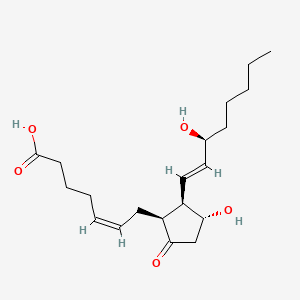| Brault S et al. |
Selective neuromicrovascular endothelial cell death by 8-Iso-prostaglandin F2alpha: possible role in ischemic brain injury. |
2003 |
Stroke |
pmid:12624307
|
| Nakamura K et al. |
Effects of 8-iso-prostaglandin E2 and 8-iso-prostaglandin F2 alpha on the release of noradrenaline from the isolated rat stomach. |
2003 |
Eur. J. Pharmacol. |
pmid:12787833
|
| Weber TJ and Markillie LM |
Regulation of activator protein-1 by 8-iso-prostaglandin E2 in a thromboxane A2 receptor-dependent and -independent manner. |
2003 |
Mol. Pharmacol. |
pmid:12695536
|
| Huber J et al. |
The isoprostane 8-iso-PGE2 stimulates endothelial cells to bind monocytes via cyclic AMP- and p38 MAP kinase-dependent signaling pathways. |
2003 |
Antioxid. Redox Signal. |
pmid:12716476
|
| Wood LG et al. |
Improved antioxidant and fatty acid status of patients with cystic fibrosis after antioxidant supplementation is linked to improved lung function. |
2003 |
Am. J. Clin. Nutr. |
pmid:12499335
|
| Cowley EA |
Isoprostane-mediated secretion from human airway epithelial cells. |
2003 |
Mol. Pharmacol. |
pmid:12869634
|
| Tintut Y et al. |
8-Isoprostaglandin E2 enhances receptor-activated NFkappa B ligand (RANKL)-dependent osteoclastic potential of marrow hematopoietic precursors via the cAMP pathway. |
2002 |
J. Biol. Chem. |
pmid:11827970
|
| Wood LG et al. |
Increased plasma fatty acid concentrations after respiratory exacerbations are associated with elevated oxidative stress in cystic fibrosis patients. |
2002 |
Am. J. Clin. Nutr. |
pmid:11916752
|
| Janssen LJ and Tazzeo T |
Involvement of TP and EP3 receptors in vasoconstrictor responses to isoprostanes in pulmonary vasculature. |
2002 |
J. Pharmacol. Exp. Ther. |
pmid:12023538
|
| Catalli A et al. |
Receptors and signaling pathway underlying relaxations to isoprostanes in canine and porcine airway smooth muscle. |
2002 |
Am. J. Physiol. Lung Cell Mol. Physiol. |
pmid:12376370
|
